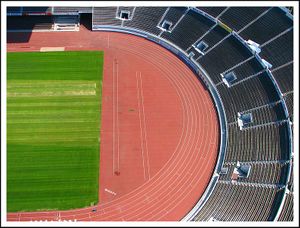Practical Interval Training

Contents
1 Injury prevention
Any problems you have with your biomechanics (running form) will often be exacerbated by running faster. It is very important to start interval training by running at a lower than ideal intensity until you get used to the faster pace. Many runners try to increase their stride length by reaching forward with their leading leg. This is called 'over striding' and involves the foot landing in front of the hip, rather than directly underneath the hip. This acts as a jarring brake, and sends a shock wave up the leg and through the body. When first doing intervals, concentrate on running lightly and efficiently. Your cadence should remain high (see tip #1, cadence) and you should listen to your feet; any slapping sound is a bad sign!
2 How to start interval training
- If you are a non-runner, start running with a run/walk program. See Starting to run
- If you are new runner, start with Fartlek and just pick up your pace a few times during your runs. This should not be an all-out sprint, but a gradual build up to a "comfortably fast" pace, then slow back down to normal.
- If you are an established runner who has done Fartlek, but not structured intervals, start with Downhill Intervals and Aerobic Intervals. It is vital that you practice Safe Speedwork and ease into structured intervals slowly; start running them slower than target pace, and build up the pace over a number of weeks.
- If you are training for a race, I would highly recommend you buy the books Jack Daniels Running Formula and FIRST.
- High Intensity Interval Training needs to be built up to with care. The nature of an "all out" pace is that it's hard to maintain good biomechanics, and it's easy to overextend or overstride.
3 Active or Passive Recovery?
Interval training involves high intensity intervals separated by recovery periods, and these recovery periods can either be passive or active. Passive recovery involves little or no exercise, such as standing still, sitting or lying down. By contrast, active recovery involves a continuing to run but at a lower intensity. This low intensity running is normally a non-specific easy pace. So which is best, active or passive recovery?
- Active recovery may allow for higher intensity intervals [1][2]. This is generally believed to be to the activity removing metabolites and burning Lactate[3] [4], but if the recovery period is 3 minutes or less, there is limited Lactate clearance even though the performance improvements remains[5].
- Passive recovery may allow for more intervals[3]. This may be because passive recovery allows the body to repay more of the "oxygen debt" and may only apply to very high intensity intervals.
- Not surprisingly, if the active recovery is too intense, than the intervals will suffer[6].
- Suddenly stopping after high intensity running can cause a drop in blood pressure and even trigger fainting.
So should you do active or passive recovery in your interval training? My recommendation is to use active recovery in nearly all situations. If complete recovery is required between intervals then use active recovery for part of the time, followed by passive recovery.
4 References
- ↑ The Effects of Active and Passive Recovery on Short-Term, High Intensity Power Output - Canadian Journal of Applied Physiology http://www.nrcresearchpress.com/doi/abs/10.1139/h93-004
- ↑ The Comparison of Active and Passive Recovery on Athlete's Women Maximum Anaerobic Power http://www.waset.org/journals/waset/v77/v77-138.pdf
- ↑ 3.0 3.1 European Journal of Applied Physiology, Volume 89, Number 6 - SpringerLink http://www.springerlink.com/content/am92g41f75ma5dt6/
- ↑ European Journal of Applied Physiology and Occupational Physiology, Volume 73, Number 5 - SpringerLink http://www.springerlink.com/content/u2x04k642382w845/
- ↑ EFFECTS OF ACTIVE VERSUS PASSIVE RECOVERY ON POWER OUTPUT DURING REPEATED BOUTS OF SHORT TERM, HIGH INTENSITY EXERCISE http://www.jssm.org/vol2/n2/2/v2n2-2text.php
- ↑ Influence of different rest intervals dur... [Eur J Appl Physiol. 2005] - PubMed - NCBI http://www.ncbi.nlm.nih.gov/pubmed/15778899
- Category:Training